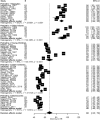Holter Monitor Rhythm Parameters in Healthy Infants, Children, and Adolescents: Defining Reference Limits With Meta-Analysis
- PMID: 40417787
- PMCID: PMC12229122
- DOI: 10.1161/JAHA.124.039783
Holter Monitor Rhythm Parameters in Healthy Infants, Children, and Adolescents: Defining Reference Limits With Meta-Analysis
Abstract
Background: Ambulatory electrocardiography has been in clinical use for 5 decades. However, reference limits for rhythm parameters in healthy infants, children, and adolescents have not been adequately defined. We sought to determine these reference ranges using meta-analysis of existing published studies of 24-hour Holter monitoring in healthy pediatric populations.
Methods: Multiple literature databases were searched from 1969 to May 2024 for relevant studies. Data extraction and analysis were completed according to the Meta-Analysis of Observational Studies in Epidemiology guidelines. The prevalence of cardiac ectopy and conduction delays along with mean±SD of heart rates were obtained and grouped by the following age ranges: neonates (birth to 4 weeks), older infants (1-12 months), younger children (1-6 years), older children (7-12 years), and adolescents (13-18 years). Ninety-five percent reference ranges for all rhythm variables were estimated in each age group.
Results: Forty-five studies including 3886 participants were identified and analyzed. Minimum, average, and maximum heart rates during Holter monitoring decreased with age as expected. Prevalence of transient first-degree atrioventricular block and Wenckebach second-degree atrioventricular block increased with age to around 14% in adolescence. Prevalence rates for any premature atrial complexes and premature ventricular complexes were also highest in adolescence at 50% and 29%, respectively. The upper limits for the number of premature atrial complexes per day were 150 in infants and 50 in the older age groups and for premature ventricular complexes were 50 in all age groups.
Conclusions: Holter monitor age-related reference limits for healthy infants, children, and adolescents are proposed.
Keywords: Holter monitor; cardiac rhythm; reference range.
Conflict of interest statement
None.
Figures




References
-
- Crawford MH, Bernstein SJ, Deedwania PC, DiMarco JP, Ferrick KJ, Garson A Jr, Green LA, Greene HL, Silka MJ, Stone PH, et al. ACC/AHA guidelines for ambulatory electrocardiography: executive summary and recommendations. A report of the American College of Cardiology/American Heart Association task force on practice guidelines (committee to revise the guidelines for ambulatory electrocardiography). Circulation. 1999;100:886–893. doi: 10.1161/01.CIR.100.8.886 - DOI - PubMed
-
- Meyer ML, Soliman EZ, Wruck LM, Mosley TH, Wagenknecht LE, Poon AK, Whitsel EA, Alonso A, Heiss G, Loehr LR. Repeatability of ectopic beats from 48‐hr ambulatory electrocardiography: the atherosclerosis risk in communities (ARIC) study. Ann Noninvasive Electrocardiol. 2017;22:e12426. doi: 10.1111/anec.12426 - DOI - PMC - PubMed
Publication types
MeSH terms
LinkOut - more resources
Full Text Sources
Medical

